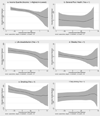When does education matter? The protective effect of education for cohorts graduating in bad times
- PMID: 25113567
- PMCID: PMC4886722
- DOI: 10.1016/j.socscimed.2014.07.056
When does education matter? The protective effect of education for cohorts graduating in bad times
Abstract
Using Eurobarometer data, we document large variation across European countries in education gradients in income, self-reported health, life satisfaction, obesity, smoking and drinking. While this variation has been documented previously, the reasons why the effect of education on income, health and health behaviors varies is not well understood. We build on previous literature documenting that cohorts graduating in bad times have lower wages and poorer health for many years after graduation, compared to those graduating in good times. We investigate whether more educated individuals suffer smaller income and health losses as a result of poor labor market conditions upon labor market entry. We confirm that a higher unemployment rate at graduation is associated with lower income, lower life satisfaction, greater obesity, more smoking and drinking later in life. Further, education plays a protective role for these outcomes, especially when unemployment rates are high: the losses associated with poor labor market outcomes are substantially lower for more educated individuals. Variation in unemployment rates upon graduation can potentially explain a large fraction of the variance in gradients across different countries.
Keywords: Education-health gradients; Europe; Unemployment rate.
Copyright © 2014 Elsevier Ltd. All rights reserved.
Figures



References
-
- Albouy V, Lequien L. Does compulsory education lower mortality? J. Health Econ. 2009;28(1):155–168. - PubMed
-
- Bagnardi V, Zambon A, Quatto P, Corrao G. Flexible meta-regression functions for modeling aggregate dose-response data, with an application to alcohol and mortality. American Journal of Epidemiology. 2004;159(11):1077–1086. - PubMed
-
- Bayne-Jones Stanhope, Burdette Walter J, Cochran William G, Emmanuel Farber, Fieser Louis F, Jacob Furth, Hickam John B, LeMaistre Charles, Schuman Leonard M, Seevers Maurice H. Smoking and Health: Report of the Advisory Committee to The Surgeon General of The Public Health Service. US Department of Health, Education, and Welfare, Public Health Service. 1964
-
- Bell David NF, Blanchflower David G. Young people and the Great Recession. Oxford Review of Economic Policy. 2011;27(Number 2):241–267.
-
- Borges-Mendez Ramon, Denhardt Lillian, Collett Michelle. Global and Local Youth Unemployment: Dislocation and Pathways. New England Journal of Public Policy. 2013;25(Iss. 1) Article 7.
Publication types
MeSH terms
Grants and funding
LinkOut - more resources
Full Text Sources
Other Literature Sources
Medical
Research Materials

